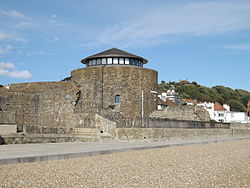| Sandgate Castle | |
|---|---|
| Sandgate, England | |
 Castle seen from the beach | |
| Coordinates | 51°04′24″N 1°08′56″E / 51.073444°N 1.148889°E |
| Type | Device Fort |
| Site information | |
| Owner | Private |
| Open to the public | No |
| Condition | Restored |
| Site history | |
| Built | 1539–40 |
| Events | English Civil War Napoleonic Wars |
Sandgate Castle is an artillery fort originally constructed by Henry VIII in Sandgate in Kent, between 1539 and 1540. It formed part of the King's Device programme to protect England against invasion from France and the Holy Roman Empire, and defended a vulnerable point along the coast. It comprised a central stone keep, with three towers and a gatehouse. It could hold four tiers of artillery, and was fitted with a total of 142 firing points for cannon and handguns.
Sandgate was taken by Parliament in 1642 at the start of the first English Civil War, and was seized by Royalist rebels in the second civil war of 1648. The castle was extensively redesigned between 1805 and 1808 during the Napoleonic Wars. The height of the castle was significantly reduced and the keep was turned into a Martello tower; when the work was completed, it was armed with ten 24-pounder (11 kg) guns and could hold a garrison of 40 men.
The castle had begun to suffer damage from the sea by the early 17th century, and by the middle of the 19th century, the receding coastline had reached the edge of the castle walls. The high costs of repair contributed to the government's decision to sell the site off in 1888. It was initially bought by a railway company and then passed into private ownership.
Coastal erosion continued and by the 1950s, the southern part of the castle had been destroyed by the sea. The remaining castle was restored between 1975 and 1979 by Peter and Barbara McGregor, who turned the keep into a private residence. In the 21st century, Sandgate remains in private ownership, and is protected under UK law as a grade I listed building.
